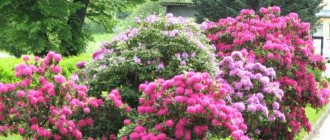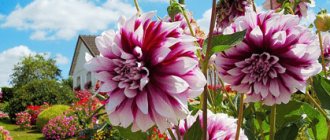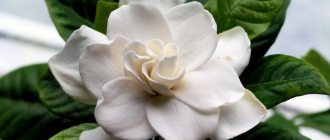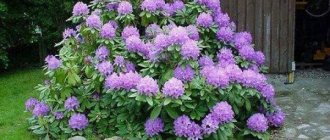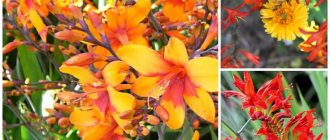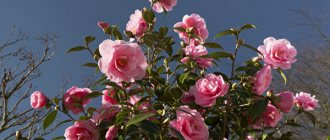Description of rhododendron
Rhododendron belongs to the heather family, which includes evergreen plants, shrubs and trees that completely or partially lose their leaves at certain times of the year. The most famous and widespread are azaleas grown indoors, in greenhouses and greenhouses.
It grows in the subtropics and temperate zone of the Northern Hemisphere, although it is also found in the Southern Hemisphere. There are 18 known species in Russia, which are distributed in the Caucasus, Siberia and the Far East. They grow singly or in groups forming entire thickets, in the mountains or under trees in the forest, in swampy areas or in the tundra. The place should be shaded and moist, but water should not stagnate in the soil. There is dampness in the air.
Types of rhododendron vary in height (from 10-20 cm to 30 m) and in flower size (several mm and more than 20 cm). Simple and compound leaves with different edges. Bisexual flowers with a corolla of different colors: lemon, pink or purple-violet. They are combined into simple and complex inflorescences, and are extremely rare alone. The fruit is represented by a five-leaf capsule that opens downwards. The seed resembles a stick 0.5-2 mm. Numerous small roots are located on the surface. Characterized by slow growth. Can be propagated in various ways.
Rhododendron is a poisonous plant containing andromedotoxin. This substance first has an stimulating effect, and then a depressant effect, leading to death. Tannins are present in the bark and leaves.
Preventing problems
For successful rooting into the substrate, it is recommended to add coniferous soil in a 1:1 ratio to the main soil mixture. Such soil will be enriched with natural microflora, forming mycorrhiza with rhododendron. “Friendly” mushrooms help roots develop better. You cannot use a universal substrate for indoor plants.
For successful formation of mycorrhiza, the soil must be:
- sour;
- warm;
- wet.
These factors must be controlled to avoid problems with roots.
Good drainage and watering in a tray will help preserve the underground part of the azalea from rotting. For planting, it is better to use a low and wide pot.
Lovers of azaleas may be interested in the following materials prepared by our experts: about pests and diseases, flowering, methods of reproduction, the healing properties of the plant, including azalea tea, as well as about growing on a trunk.
Types and varieties of rhododendron
Typically, shrub varieties are grown in gardening.
| View | Description of the bush | Sheet | Flower |
| Deciduous | |||
| Daursky | Medium with great branching. Early flowering. Steel-colored bark, thin reddish-brown shoots with slight pubescence. | Elongated, green, lemony in autumn. 5 cm | Purple-pink in the shape of a funnel. |
| Kamchatsky | Miniature in the shape of a hemisphere. Dwarf. | Large, ovoid. 5 cm | Bright carmine. Inflorescence of 3 pcs. with a velvety surface. |
| Canadian | Low, compact up to 1 m. Twisty, thin strong branches. | Elliptical, bluish-green. | Pink-lilac. The heavily cut petals resemble a moth. |
| Evergreens | |||
| Caucasian | Creeping shoots up to 1.5 m. Dark brown bark. | Dark green, smooth above and hairy below. | Fragrant, yellow with green specks or white. Bell shape. Brush of 8-12 pcs. |
| Smirnova | Young branches have slight white pubescence, old branches have gray bark. up to 1-2 m. | Oblong-elliptical 8-10 cm. | Purple in the form of a bell. |
| Adams | Branched 0.5 m. Shoots covered with glandular hair. | An elongated ellipse, bare above, with scales below. Ginger. | Various pink shades. Corymbose inflorescences 7-15 pcs. |
| small-leaved | Beautiful, compact. Young branches are rusty in color, old ones are steel. Straight or creeping. 0.5-0.6 m. | Oblong-lanceolate. | Golden 3 cm. |
Planting rhododendron
In order for rhododendron to grow on a site, it needs to choose a suitable place, prepare the soil and properly plant and care. Deciduous species require a lot of light, while evergreen species require shade. All of them require shelter from the wind, and in winter from snow, so it is better to plant them near buildings, fences or tall plants. Trees that have the same structure of the root system are not suitable as neighbors: birch, spruce, maple and others. They can grow near oak, pine and fruit plants: apple, pear, cherry.
Rhododendrons prefer loose, acidic soil (4.5-5.5 pH), which freely provides access to air and water (does not linger). Sandstone and loams are deoxidized by adding peat, compost, pine needles, and bark.
Bushes at the age of 2-3 years are transplanted into a recess of 30x30 cm, older ones - into a recess of 60x40. A drainage made of crushed brick or large gravel is placed on the bottom, a special mixture of soil, peat, rotten pine needles, sand, compost (humus) is placed on top and it is well moistened so that it settles. The roots of the plant are placed in water and kept in it until the air bubbles disappear. The depth level is 3-4 cm above the root. After planting, the soil is moistened and mulched with a mixture of peat, sand and crushed pine bark.
Preparing for winter
Before wintering, deciduous varieties are watered abundantly throughout the fall.
Young seedlings need good shelter for the winter. It is necessary to cover the roots and root collar with a thick layer of mulch. The branches are protected from wind and frost with lutrasil or spandum.
The roots of an adult plant require an additional layer of needles from 5 to 20 cm in height. For the branches, a frame is constructed from boards or rods that will not fit tightly to them.
The frame is covered with spandum on top, leaving a hole for ventilation.
Rhododendrons covered for the winter
It is important to know! Shrubs should be insulated when the temperature drops steadily to -10°C.
With the onset of spring, it is important to monitor the weather - if the air has warmed up enough, but the soil is still frozen, then you need to turn on warm watering to actively awaken the root system of the shrub.
Rhododendron care
Care for the plant following the rules:
- Water depending on the weather and drying of the soil. At the beginning of development, sufficient moisture with soft water is required: in summer - 1-1.5 buckets per mature plant 4 times a month, in hot weather - more often. When it gets cooler, less often - every 1.5 weeks. Water with acidified water (10-15 g of oxalic or citric acid per 10 l).
- Feed with mineral fertilizers. In the spring to revive the plant and begin its flowering. In the summer, to speed up the growth of shoots and the formation of buds for the next year. In autumn (without nitrogen) - to prepare for winter.
- Prune in the spring, removing dry and diseased shoots. You can shorten those branches that disrupt the shape of the bush. Withered flowers are torn off, otherwise the plant looks sloppy. It is necessary to direct energy to the growth of new branches and flowers.
- Transplanted at any age. It is best before the sap begins to flow - in the spring, later - after flowering or at the very beginning of autumn, so that it has time to get stronger before the beginning of winter.
- A winter-hardy plant, but it is better to cover it during the cold period.
Features of growing in cold climates
Some gardeners, having chosen a beautiful specimen of rhododendron and planted it on a plot in the Moscow region, are disappointed, since the bush does not take root and freezes at the first frost. This is not surprising, since the plant was chosen incorrectly.
There are specimens suitable only for warm regions. Planting just such bushes gives unsuccessful results.
Among rhododendrons there are cold-resistant varieties
Residents of the Leningrad region and Moscow region can grow rhododendron in their garden if they choose the right variety. And then the bush will delight gardeners with its exotic beauty.
Among rhododendrons there are cold-resistant varieties. These are deciduous plants of the following varieties: Phukansky, Kamchatka, Schlippenbach, yellow, Japanese. Of the evergreens, the following are suitable: Cavtenby (hybrids: Nova Zembla, Abraham Lincoln, Alfred, Kenningham), Smirnova (hybrids Laika, Dorothy Swift, Gabriel), the largest, golden, short-fruited.
Northern Light plants are suitable for the cold of central Russia: Spicy Lights, Pink Lights, Rosie Lights. Finnish varieties have recently been developed for harsh climates: Hague, Elvira, Mikkeli.
It is not enough to have a cold-resistant variety; you need to plant it correctly and provide the necessary care.
Having chosen a shady place, you need to prepare a soil mixture by mixing peat with garden soil and pine needles. Rhododendron mixture can be purchased at the store. Complex mineral fertilizer is added to the soil. The bush must be planted while maintaining a distance from other trees, the distance should be at least a meter so that the roots do not interfere with the development of the bush.
If the soil is clayey, a 15 cm layer of broken brick is poured onto the bottom of the pit. The size of the pit should be twice the size of the container with the plant. When planting, it is not recommended to bury the root collar of the bush; it should be flush with the surface of the earth. After compacting the soil, the rhododendron needs to be watered.
Caring for the plant is the same as for a regular garden species.
It is necessary to adhere to certain rules, these are:
- maintain soil acidity at the proper level, avoid alkalization. Avoid getting ash, dolomite, lime into the soil, as these substances alkalize the soil.
- You cannot loosen the soil around the planting , as you can damage the root system located close to the surface of the earth. Mulching is used instead
- plant rhododendron on the northern shady side of the site. Protect the bush from direct sunlight by covering it with cloth or gauze.
- do not flood the plant. In summer, water twice a week.
Constantly falling rains in the fall can cause rapid growth of numerous shoots. Since they die with the onset of cold weather before they have time to ripen, their appearance can be avoided by spraying the bush with potassium monophosphate or sulfate (1.0%). This procedure prevents the development of young shoots and promotes the formation of flower buds.
You cannot water the plant after spraying, even if the weather is dry.
Before the onset of cold weather, the bush is covered with a frame with film and secured with twine to prevent cold air from entering.
Reproduction
There are several methods of propagation: seeds, dividing the bush, layering and cuttings.
The seeds are sown shallowly in a bowl filled with a damp mixture of peat (heather) soil and sand in a 3:1 ratio. For a greenhouse effect, cover with glass or cellophane and place in the light. Aerate, irrigate and remove condensate daily. Shoots will appear in 30 days. Transplant the seedlings into another container after two leaves appear (diagram 2x3 cm). In the garden - for the 2nd year, and before that they are grown in a greenhouse. Flowers will appear at the age of 6-8 years.
A cutting is prepared from a part of the stem (5-8 cm) with unripe wood and leaves. The lower leaves are torn off and dipped in a stimulant solution for half a day. Then they stick it into the soil (peat and sand 3:1), on top - a jar or bag so that the roots grow (1.5-4 months), after which a container with soil is needed (peat and pine needles 2:1). In winter, place it in a room with +8...+12 °C and flooded with light. In spring and summer they are transferred to the garden, to the final site - after 2 years.
The easiest way to propagate is by layering: a flexible branch is bent into a groove (15 cm), secured with wire and covered with soil. The top is tied to a pole. The care is normal. In autumn or spring you can separate it from the main plant and replant it.
Divide the bush into parts, which are planted separately. In a year, young branches will appear and flowering will begin.
Choosing seedlings
Rhododendron Nova Zembla
It is best to purchase young seedlings from trusted sellers to avoid a bad breeding experience.
The most successful seedlings will be those grown in pots or in open ground in the same climate where the future bush will grow.
Deciduous rhododendron seedlings
It is important to know! If a plant is grown in greenhouse conditions, it will not adapt to growing conditions in open ground and will quickly die.
To increase the likelihood of good rooting and growth of the future bush, the seedling must be:
- age 2-4 years;
- well bushy, and the shoots should extend from the very base of the bush trunk;
- with smooth, healthy leaves of dark green color (if purchased in the fall, yellow or red colors are possible);
- with healthy roots, without signs of rot and dark spots.
Young bushes grown in the right conditions will be short:
- grown from seeds - 12-15 cm in height;
- obtained by cuttings - 20-25 cm.
It is important to know! If a 4-year-old seedling is about a meter high, this is a sign of greenhouse cultivation.
Diseases and pests
Rhododendron is susceptible to attack by certain pests and a number of diseases.
| Pest | Symptoms (on foliage) | Elimination measures (spraying) |
| Rhododendron bug | Small white markings. Below are insect eggs (brown). | Diazinon. |
| Asian garden beetle | The hole is irregularly shaped or only veins remain. | |
| Mealybug | Wrong shape. Death. | Karbofos. Repeatedly. |
| Grooved weevil (fluted weevil) | The edges are damaged, the bark near the root is eaten away. | 0.3% karbofos emulsion, for irrigation 0.2-0.3%. At the end of summer, 0.1-0.15% liquid Bazudin or diazinon and Furadan are used. |
| Spider mite | Below is a thin web. Steel brown color. They fly around. | Agravertine, diazinon. |
| Tillable slug | Through holes appear very quickly. | 0.8% TMTD. Collection of adult specimens. |
| Black thrips | Gray holes on top, dark ones on bottom. Steel tint, shedding. The inflorescence is ugly. Development is slowing down. | 0.2-0.3% nicotine. 0.2% karbofos emulsion. |
| Narrow-winged miner moth | The surface is stained. They curl into a tube, dry out, crumble and crumble. | Spraying or fumigating with sulfur. |
In addition to pests, rhododendrons are susceptible to some diseases.
| Manifestation on leaves / Symptoms | Disease / Causes | Corrective measures |
| Yellowness. Curling, drying out. Flowering is weak. | Mixed chlorosis. There are not enough batteries. Stagnant water, dense soil around the root system or has become alkaline. | Foliar feeding with iron salt of sulfuric acid 7.5 g/l, magnesium 6.5 g/l. |
| Red spots, curling, drying out. | Sulfuric acid salt or ammonium nitrate. Potassium nitrate. | |
| Brownish on top. | Necrosis. Reducing the ambient temperature. | Cover. |
Each case of disease requires identification of the causes and their elimination.
The benefits and harms of rhododendron
Rhododendron is used to decorate areas, but it has useful qualities that are used in conventional and folk medicine. The presence of vitamin C, andromedotoxin, ericolin, arbutin and rhododendrin led to its use:
- will help reduce fever and pain;
- will have a calming and bactericidal effect;
- relieve swelling;
- removes excess fluid from the body;
- will lower the pressure.
Contraindications: pregnancy, breastfeeding, kidney disease and tissue necrosis.
It is best to carry out treatment in consultation with a doctor. This will protect you from unwanted consequences or death, which is possible because many species are poisonous.
